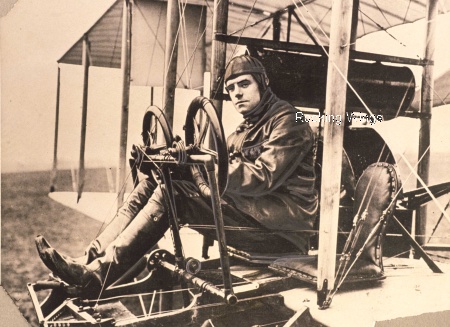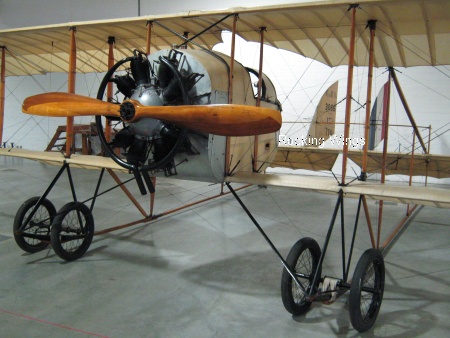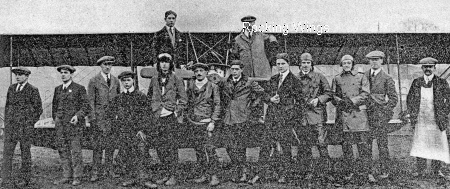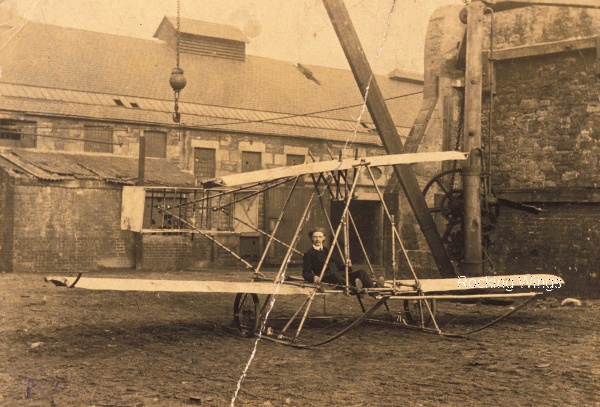A brief history of Preston Watson's aviation career

Preston Watson at the controls of a Beatty Wright aeroplane, whilst gaining his Royal Aero Club Certificate at the London and Provincial School at Hendon in 1915. The Trustees of the National Museums of Scotland
Born in Dundee, Tayside on 17 May 1880, the son of Mr Thomas Watson of Balgowan and his wife Jane, Preston Albert Watson was a pupil of Dundee High School and showed considerable interest in things mechanical from an early age. He was also a keen sportsman; recognised as a Scottish national champion hurdler and rugby player for Newport, who won the North of Scotland Rugby Challenge Cup for the 1898 to 1899 season.
Aside from his prowess on the sports field, young Preston possessed an analytical mind, and quite often, he, according to the Sunday, 27 October 1984 edition of The Courier and Advertiser newspaper;
"...would sometimes sit overlooking the Firth of Tay and watch seagulls in flight. "One day too, we will be able to fly", he is said to have remarked prophetically, only to be chided by his brother, James (later his great aviation ally) and friends for an idea that was 'just daft'…"
It was in his Twenties whilst studying engineering at the University College of Dundee that his interest in aeronautics flourished, but, for a keen and impressionable young adult there was little to read on the emerging science of aviation. If aviation was to become the field in which he was going to start a career, he would have to do his own research.
His brother James was to later recount in the December 1955 issue of Aeronautics magazine that;
"Before the last century [Preston] studied the flight of gulls, caught many of them, put small weights on their heads, glued their wings into the position he wished, and was frequently seen by passers-by dropping them over the road bridge, which crossed the railway line at the west end of the Dundee Esplanade."
According to the late Mr James Manson, who worked as a labourer with Watson's father's food produce business, Messers Watson and Philip, Preston built small model aeroplanes and dropped them from the bridge at Ninewells.
On 25 October 1907 Watson applied for a patent that, "...relates to flying machines, the object being to raise and propel a machine through the air without aerostats." Accepted in its entirety nearly a year later, Patent No.23,553 of 1907, titled Watson's flying machines comprises eight pages of descriptions of an indigenous rotary-wing means of creating lift and five illustrations to which the description pages are keyed to. These show different configurations of aircraft using the same rotary aerofoil devices that resembled the sheathing mechanism of a combine harvester. No evidence survives to suggest Watson began constructing any of the bizarre creations in the patent.
Accepted in its entirety on 8 October 1908, by that time Watson’s ideas on what constituted successful flight, and specifically how lift was achieved had changed dramatically from his patent. In July 1908 Watson published the pamphlet Power necessary in flight (John Leng & Co. Ltd. Dundee, 1908), which contained his theories on;
"...the best curvature of an aerodrome [sic], and, further, the result of a calculation regarding the best proportion of the weight of wings to weight of structure for the attainment of flight with the least horse-power."
Obviously influenced by Frederick William Lanchester's paper titled Aerodynamics, constituting the first volume of a complete work on aerial flight published in December 1907, Watson's work contains an analytical approach to aerodynamics, far removed from the outlandish theories he expressed in his first patent. Watson's introduction mentions that he had read Lanchester's work, stating that their findings are similar, but that he arrived at his theories independently.
His next patent represented the body of his aeronautical work that he spent the rest of his life researching; his rocking wing concept of lateral control. Applied for on 1 January 1909, the complete specification is dated 23 July 1909 and was left with the Patent Office a day later and accepted on 16 December that year. Patent No.47 of 1909 comprises three pages of descriptions and a single page with an illustration of the rocking wing concept as applied to a theoretical aeroplane.
From examining the illustration supplied with the patent and surviving photographs of Watson’s aeroplanes, it is plainly evident that he had fully intended on constructing an aircraft based on his patent. Exactly when he completed his first aeroplane is not known, but on page 400 in the 2 November 1909 issue of The Aero magazine is the following statement;
“At the secluded little village of Forgandenny, Perthshire, near Preston, A. Watson, a well-known motorist of Dundee, has built a machine to his own designs. Mr Watson does not wish details of his aeroplane to be made public till he has tested it in practice, which he hopes to do within the next few days.”
Although clearly a typographical error with regards to the location of “the secluded little village of Forgendenny, Perthshire, near Preston” and Watson’s name, this article seems to confirm a likely completion time period. According to J. D. Gillies and J. L. Wood in the book Aviation in Scotland, published by the Glasgow branch of the Royal Aeronautical Society in 1968, his No.1 was not a success. Its engine was removed and it was given to the Dundee Model Aero Club a year later.

A Caudron G.3 on display at the RAF Museum, Hendon. In detail the Caudron and Watson's aeroplanes had similarities, such as the bungee sprung wheels; Watson's last aeroplane was powered by a 6 cylinder Anzani, with which many Caudrons (not this one) were fitted. It was in a Caudron G.3 like this one in which Watson lost his life in tragic circumstances. Grant Newman
The first time an image of one of Watson’s aircraft flying appears in the British press is in the 15 May 1914 issue of Flight magazine. Two images of his second aeroplane are seen in the air in the photographs taken at Errol, Perthshire in 1912. After these pictures appeared, a clear photograph of his No.2 at rest came to light. Much detail of the construction of Watson’s machines was revealed in this image, including the powerplant, from which an effective date of construction of the No.2 can be ascertained. Powered by a three cylinder 30 hp Humber engine, it is assumed the earliest Watson’s No.2 could have been built is 1910.
In an article in the 15 April 1914 issue of the French aviation periodical L'Aerophile , two images of Watson's third, and last aeroplane appear as it was at the Concours de La Securite en Aeroplanes competition held at Buc, France, one showing the machine in flight and the other from front on. Both were published in Flight a month later with more pictures of the No.3 from the same photoshoot, although credited to Flight this time.
By far the most revealing article published on Watson, the three page write-up in Flight, penned by the aviator himself describes in detail how his rocking wing concept worked, with illustrations of the No.3 taken in France accompanying the article. Constructed in 1913, this aircraft is bigger and appears sturdier than his previous efforts, being constructed of steel tubing rather than bamboo, as its predecessors were.
Watson had the article published in support of his entering the No.3 in the first Concours de La Sécurité en Aéroplanes competition held at Buc, France between 1 January and 1 June 1914. The script Watson supplied the magazine for publishing was that which he supplied the organisers of the competition in France as a requirement of its rules.
The only British entry in the competition designed to highlight safety measures in aircraft design, Watson’s No.3 was ruled out of the competition due to either the pilot he had invested in being considered too inexperienced, or as one periodical states, his machine was underpowered and could not remain aloft for too long. Mr S. Summerfield of Melton Mowbray, who owned his own Blériot XI monoplane was entrusted with the task of demonstrating the No.3, although why Watson did not fly himself is unknown.
In March 1915 during an interview with a Flight magazine reporter, Watson mentioned that he had fitted floats to the No.3, “...for flying over water…” It is most likely that these were floatation devices that provided buoyancy in the event of the aircraft ditching during over-water flights. Watson said that he intended on carrying out further experiments with the No.3 after the end of the war, since he had applied for a commission with the Royal Naval Air Service.

Staff and pupils of the L & P School at the London Aerodrome at Hendon. Watson is fourth from right, with New Zealander Clive Collett, a future Great War fighter ace on his left. Flight via the National Mueums of Scotland
On 16 March 1915, Watson was awarded his Royal Aero Club Certificate, No.1,117, the equivalent of achieving a pilot’s licence, after instruction with the London and Provincial School at the London Aerodrome, Hendon. At the bottom of page 145 in the 26 February 1915 issue of Flight is a photograph of students and instructors of the London and Provincial School; Watson can be seen wearing a leather flying cap standing next to a sheepish looking Clive Collett, later Capt. Clive Franklin Collett MC, Great War fighter ace from Blenheim, New Zealand and the first member of the Royal Flying Corps to parachute out of an aeroplane.
Sadly, the next we hear about the intrepid Scot are from his obituaries. On 30 June 1915 Flight sub-Lieutenant Watson, RNAS was killed when his Caudron G.3 broke up in mid air near Cross-in-Hand, Sussex. He was 35 years old. Buried on 5 July 1915 in Dundee's Western Cemetery, he was survived by a widow and two young children. What became of his aeroplanes and his research is not known.
As a tribute to the intrepid aviator, in the Perthshire town of Errol near where he made his first powered flights, Preston Watson Street has been dedicated and lined with two storey villas, with an average value of 200,000 Pound (St) each.
Next, read about Watson's bizarre 1907 patent here
